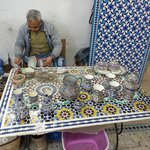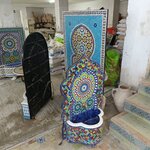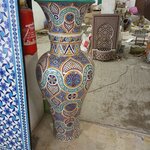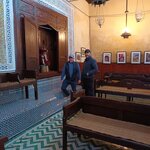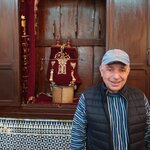Highlights
- Visit the Hassan II Mosque and the world's second-tallest minaret in Casablanca
- Discover souks, tanneries, and artisan workshops in medieval Fes
- Take a day trip to Sefrou, nestled on the slopes of the Middle Atlas
- Wander the quiet, blue-washed streets of Chefchaouen
Brief Itinerary
| Day | Highlights | Overnight |
|---|---|---|
| Day 1 | Arrive in Casablanca | Casablanca |
| Day 2 | Transfer to Rabat, Explore | Rabat |
| Day 3 | Rabat to Fes via Meknes & Volubilis | Fes |
| Day 4 | Explore the Imperial City & Medieval Medina of Fes | Fes |
| Day 5 | Day Trip to Sefrou | Fes |
| Day 6 | Fes to Chefchaouen, the Blue City | Chefchaouen |
| Day 7 | Transfer to Tangier via the Cave of Hercules | Tangier |
| Day 8 | Explore Tangier | Tangier |
| Day 9 | Depart Tangier |
Detailed Itinerary
Day 1: Arrive in Casablanca

Welcome to Morocco! Depending on your arrival time, you might like to book yourself in for a half-day tour of Casablanca, the commercial capital of Morocco. If you only visit one place in Casablanca, make it the Hassan II Mosque, sitting in a picturesque location on the sea. While the exterior and surrounding area are impressive, what makes this mosque even more unique is that it is of the few mosques in the country that non-Muslims can enter—Marvel at the interior's lavish woodwork, marble, carved stone, and gilded ceilings.
With a bit more time in Casablanca, you might like to check out the Hobous, the city's New Medina for French art deco architecture, the Boulevard de la Corniche for a stroll, and Rick's Café, which recreates the famous "Casablanca" movie scene.
Day 2: Transfer to Rabat, Explore

Venture north to Rabat's imperial city and present-day capital, a bustling city with several sights and a rich history.
Explore the medieval fortification of the Chellah Necropolis in the heart of Rabat and wander the Roman and Islamic ruins. Step back in time to Rabat's original city center and enter through the grand door of the Kasbah des Oudaias. Primarily a residential area today, quietly wander the peaceful white and blue-hued streets. From there, visit the 20th-century Andalusian Gardens and enjoy the serene space away from the crowds. Discover the Hassan Tower, a minaret of the incomplete mosque and Mausoleum of Mohamed V. A 12th-century project that was abandoned.
Day 3: Rabat to Fes via Meknes & Volubilis

Meet your driver and head east toward Fes. Along the way, stop and stretch your legs to visit the Roman ruins of Volubilis. A UNESCO-protected site founded in the third century BCE, it remains incredibly well-preserved. Next, stop and explore Meknes. A smaller version of Fes, Meknes offers a calmer medina, and shopkeepers are not as pushy to make a sale. While Meknes is quite large, the two main areas of interest are the Ville Impériale (Imperial City) and the manageable medina. Check out the grand Bab al-Mansour gate, the Mausoleum of Moulay Ismail, and the massive underground Royal Stables.
Carry on eastward to Fes. With your driver, take the time to make your way up a hill to the ruins of the Merenid Tombs for an all-encompassing view of the medieval city. The best time to visit the tombs is around dusk. The muezzin's calls to worship can be heard through the valley as the city lights begin to glow, adding to the atmosphere. Return to your traditional riad for a warm meal and settle in for the evening.
Chat with a local specialist who can help organize your trip.
Day 4: Explore the Imperial City & Medieval Medina

Fes is the oldest of Morocco's imperial cities and perhaps the most interesting and exciting to explore. It has the most complete medina in the Arab world and has been relatively untouched since it was founded over 1,000 years ago. Often considered the country's cultural capital, it comprises three parts, two medina quarters, Fes el Bali and Fes el Jdid, and the more modern, French colonial-influenced Ville Nouvelle. Meet your guide and spend a half day learning about the history and culture as you navigate the narrow streets of the medinas.
Start in Fes el Bali at the Bab Boujeloud gate and enter the main thoroughfare of Talâa Kebira. Notice the Spanish and Tunisian-influenced architecture as you make your way past shops and souks (markets). One of the unique sights in the Old Medina is the tanneries, and Chouara Tannery is no exception. Next, climb to the rooftop of a nearby leather shop for a better view of the 11th-century stone pots filled with dye and men at work still using centuries-old techniques. From there, find your way to the 14th-century Al Attarine Madrasa and admire the intricate zellij tilework.
The best way to end your day of discovery is by taking in the sunset from the Merenid Tombs in the north (if you did not do this the night before) or Borj Sud in the south. Both viewpoints offer fantastic views over this dynamic city.
Day 5: Day Trip to Sefrou

Meet your guide at your riad and embark on an hour's drive to Sefrou. A walled town nestled in the slopes of the Middle Atlas mountains, just 17 miles (28 km) southeast of Fes. The city began as a market town in the Roman era and a stopping point for caravans of traders making their way from the Mediterranean to the Sahara Desert. It became a major Moroccan town long before Fes was built in the eighth century. Agriculture is the main activity in the region. The mountainous terrain is the ideal place for fruit trees, especially cherries.
You'll visit Sefrou's Craft Center (Ensemble Artisanal de Sefrou). This beautiful complex is located by the old city, and it is home to several workshops where artisans work on wood, ceramic, rug weaving, and even silk djellaba buttons. Here you will get the chance to see their work and learn their craft. You'll return to Fes in time for dinner.
Day 6: Fes to Chefchaouen, the Blue City

As you leave Fes, stop at the Merenid tombs for one last panorama before hitting the road toward the striking blue city of Chefchaouen in the Rif mountains. Before you reach the city, stop to hike (2-3 hours) through lush vegetation and small pools to enjoy the Cascades d'Akchour (Waterfalls of Akchour), then carry on. Mostly untouched since the 15th century, Chefchaouen offers a relaxed atmosphere with some of the friendliest people in the country and is known for its blue-washed buildings in its historic medina. Explore its narrow streets and alleyways, which cling to the northern hillside of the mountains.
Discover Plaza Outa el-Hammam, the main square named for the number of hammams (public baths) that encircled it. Find a restaurant or café for a bite to eat before browsing the many shops offering traditional wares. Visit the Grand Mosque and kasbah (old fortress or fortification) and tour the kasbah's garden, museum, and even some of its old prison cells. As the evening approaches, ascend the path to the never used, white Spanish Mosque (20 to 30 minutes) to enjoy the view over Chefchaouen as the sun sets behind the mountains.
Day 7: Transfer to Tangier via the Cave of Hercules

Enjoy a leisurely morning in Chefchaouen before you hit the road to Tangier. Consider stopping en route to explore more of the Rif mountains and perhaps spend a couple of hours hiking along the Cascades d'Akchour.
Before you arrive, you'll have a chance to check out the Caves of Hercules, 20 minutes outside Tangier. When seen against the Atlantic horizon, the cave's outline is thought to resemble the shape of the African continent.
Day 8: Explore Tangier

Tangier is a major entry point from Europe to Africa. Located close to the south of Spain, visit the medina, a café in the hip Zoco Chico square to relax, and people watch or take a paseo to enjoy a stroll along the promenade when the sun begins to creep on the horizon. To check out the compact Tangier Kasbah, enter through Bab Haha into Place du Mechouar for a leisurely self-guided walk. And if you ran out of time to visit the Caves of Hercules at Cape Spartel yesterday, you have a second chance today.
Day 9: Depart Tangier

Spend the morning enjoying Tangier before departing from the airport or via a ferry.
More Great Morocco Itineraries
Looking for more inspiration for your trip to Morocco? Check out these other Morocco itineraries, explore different ways to spend nine days in Morocco, or discover the best time to visit Morocco.



